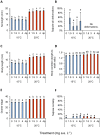Non-target effects of a glyphosate-based herbicide on Common toad larvae (Bufo bufo, Amphibia) and associated algae are altered by temperature
- PMID: 27833808
- PMCID: PMC5101619
- DOI: 10.7717/peerj.2641
Non-target effects of a glyphosate-based herbicide on Common toad larvae (Bufo bufo, Amphibia) and associated algae are altered by temperature
Abstract
Background: Glyphosate-based herbicides are the most widely used pesticides in agriculture, horticulture, municipalities and private gardens that can potentially contaminate nearby water bodies inhabited by amphibians and algae. Moreover, the development and diversity of these aquatic organisms could also be affected by human-induced climate change that might lead to more periods with extreme temperatures. However, to what extent non-target effects of these herbicides on amphibians or algae are altered by varying temperature is not well known.
Methods: We studied effects of five concentrations of the glyphosate-based herbicide formulation Roundup PowerFlex (0, 1.5, 3, 4 mg acid equivalent glyphosate L-1 as a one time addition and a pulse treatment of totally 4 mg a.e. glyphosate L-1) on larval development of Common toads (Bufo bufo, L.; Amphibia: Anura) and associated algae communities under two temperature regimes (15 vs. 20 °C).
Results: Herbicide contamination reduced tail growth (-8%), induced the occurrence of tail deformations (i.e. lacerated or crooked tails) and reduced algae diversity (-6%). Higher water temperature increased tadpole growth (tail and body length (tl/bl) +66%, length-to-width ratio +4%) and decreased algae diversity (-21%). No clear relation between herbicide concentrations and tadpole growth or algae density or diversity was observed. Interactive effects of herbicides and temperature affected growth parameters, tail deformation and tadpole mortality indicating that the herbicide effects are temperature-dependent. Remarkably, herbicide-temperature interactions resulted in deformed tails in 34% of all herbicide treated tadpoles at 15 °C whereas no tail deformations were observed for the herbicide-free control at 15 °C or any tadpole at 20 °C; herbicide-induced mortality was higher at 15 °C but lower at 20 °C.
Discussion: These herbicide- and temperature-induced changes may have decided effects on ecological interactions in freshwater ecosystems. Although no clear dose-response effect was seen, the presence of glyphosate was decisive for an effect, suggesting that the lowest observed effect concentration (LOEC) in our study was 1.5 mg a.e. glyphosate L-1 water. Overall, our findings also question the relevance of pesticide risk assessments conducted at standard temperatures.
Keywords: Agrochemicals; Agroecology; Algae; Amphibia; Aquatic organisms; Climate change; Ecotoxicology; Herbicides; Non-target effects; Pesticides.
Conflict of interest statement
The authors declare that they have no competing interests.
Figures



References
-
- AGES List of authorised/approved plant protection products in Austria. 2015. http://pmg.ages.at. [29 September 2015]. http://pmg.ages.at
-
- AlgaeBase Database of information on algae that includes terrestrial, marine and freshwater organisms. 2015. http://www.algaebase.org. [2 October 2015]. http://www.algaebase.org
-
- Arnold EN, Ovenden D. A Field Guide to the Reptiles and Amphibians of Britain and Europe. London: HarperCollins; 2002.
LinkOut - more resources
Full Text Sources
Other Literature Sources
Molecular Biology Databases

